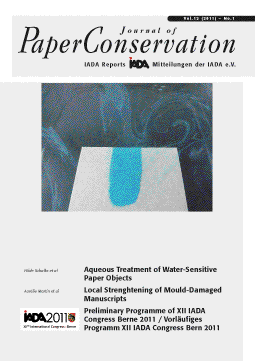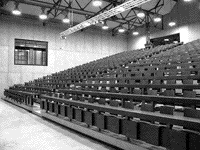VOL.
12 (2011), NO. 1

|
|
|
|
|
AQUEOUS TREATMENT OF WATER-SENSITIVE
PAPER OBJECTS
Capillary Unit, Blotter Wash or Paraprint Wash?
KAPILLARREINIGUNG, BLOTTER-WASH ODER
PARAPRINT-WASH?
Wässrige Behandlung von wasserempfindlichen Objekten
Authors/Autoren: Hilde
Schalkx, Piet Iedema,
Birgit Reissland,
Bas van Velzen,
Abstract: Blotter washing and
washing with the capillary unit are both methods used for aqueous
treatment of water-sensitive paper objects. The challenge of this
treatment is to remove water-soluble products while keeping the
water-sensitive medium in its place. In this article the two methods
are compared, along with a third method referred to as Paraprint
washing. This is a washing treatment similar to blotter washing,
but using Paraprint OL 60, the viscose non-woven fabric recommended
in the literature for use with the capillary unit, instead of blotting
paper. Preliminary experiments were carried out to clarify the principles
behind the capillary unit treatment, and the method was adjusted
to use a level surface instead of the slight slope recommended in
the literature. The comparison between the different methods was
made by washing samples of new, unaged papers, that had been coloured
by immersion in a highly water-soluble red food colouring dye (Ponceau
4R) to simulate the water-soluble compounds like discolouration
and acids that washing is usually meant to remove. After treatment
the samples were compared visually. Both capillary unit treatment
and Paraprint washing gave better results than the more traditional
blotter wash. The capillary unit worked well with papers that wet
easily. For papers that did not, Paraprint washing was better suited
as it washed out the colour more effectively and evenly. Finally,
originals were successfully treated applying the results of this
study.
Zusammenfassung: Das
„Blotter-Washing“ und die „Behandlung mit der Kapillareinheit“ sind
beides wässrige Methoden zur Behandlung wasserempfindlicher
Objekte. Die Herausforderung besteht darin, wasserlösliche
Produkte zu entfernen, dabei jedoch die wasserempfindliche Bildschicht
auf dem Träger zu erhalten. In diesem Artikel werden diese
beiden Methoden sowie eine Abwandlung des Blotter-Washings, das
„Paraprint-Washing“, verglichen. Hierzu wurden neue, ungealterte
Papiere wässrig behandelt. Um den Transport unsichtbarer wasserlöslicher
Verunreinigungen (Verfärbungen, Säuren) sichtbar zu machen,
waren diese Papiere zuvor mit einem wasserlöslichen, roten
Lebensmittelfarbstoff (Ponceau 4R) durch Tauchen gefärbt worden.
Nach der Behandlung wurden die Proben visuell verglichen. Die Kapillareinheit
und das Paraprint-Washing erzielten bessere Ergebnisse als das eher
traditionelle Blotter-Washing. Eine Behandlung mit der Kapillareinheit
ist effektiver für Papiere, die Wasser gut aufnehmen. Für
schlecht benetzbare Papiere ist das Paraprint-Washing geeigneter,
die Farbe wurde besser und gleichmäßiger entfernt. Schließlich
wurden Originale unter Berücksichtigung der Ergebnisse dieser
Studie erfolgreich behandelt. Die Verwendung der Kapillareinheit
konnte durch einleitende Experimente wesentlich vereinfacht werden:
ein geneigter Winkel ist nicht notwendig.
Keywords: Background - Capillary
Unit Treatment (Wetting the Paraprint OL 60 - Establishing a Water
Flow within the Paraprint OL 60 - Moistening the Object - Transport
of Solutes out of the Object into the Paraprint OL 60 - Transport
of Solutes Through the Paraprint OL 60 - Covering the Capillary
Unit) - Blotter Washing (Wetting the Blotting Paper - Moistening
the Object - Covering the Blotter-Wash Container or Screen-Printing
Screen - Transport of Solutes out of the Object into the Blotting
Paper - Changing the Blotters - Keeping the Blotter-Wash Container
Uncovered) - Paraprint Washing - Hypothesis - Experimental (Sample
Preparation - Preparation, Washing Duration, Drying - Capillary
Unit Treatment - Blotter Wash and Paraprint Wash - Case Studies)
- Results and Discussion - Conclusions - Acknowledgements - Endnotes
- References - Suppliers - Authors
|
|
LOCAL STRENGHTENING OF MOULD-DAMAGED
MANUSCRIPTS
A Case Study on Logbooks of Early French Expeditions in Louisiana
(1684-1722)
LOKALE VERSTÄRKUNG SCHIMMELGESCHÄDIGTER
MANUSKRIPTE
Ein Fallbeispiel von Logbüchern früher französischer
Expeditionen nach Louisiana (1684-1722)
Authors/Autoren: Aurélie
Martin, Véronique Rouchon,
Thierry Aubry, Nelly
Cauliez, Marthe
Desroches, Marlène Margez
Abstract: The National Archives
in Paris house the logbooks of early French expeditions in Louisiana,
preserved in their original binding. They raise current conservation
issues specific to archival materials: iron gall inks are relatively
well preserved but the paper is extremely weak on the edges, as
a result of old water damages and micro-organisms growth. Using
local consolidation techniques to strengthen the paper of these
documents would prevent us from removing the bindings, hence allowing
for minimal interference. But these methods generate a substantial
number of risks: formation of tide lines more likely to turn brown
over time, local distortion of the paper, and iron gall ink migration.
Often underestimated, the latter aspect should prevail in the decision-making
process. Indeed, the formation of halos around and on the verso
of the ink lines is often barely noticeable to the naked eye, but
always comes with a migration of iron-ions, which is particularly
detrimental to the manuscripts. We therefore sought the parameters
of a local re-sizing technique that would limit, as much as possible,
tide lines, distortions and ink migrations. We finally opted for
a 2 % Klucel G® in ethanol as adhesive and re-sizing agent. The
solution was applied directly with a brush on damaged areas, in
a local procedure combining re-sizing, lining with Berlin tissue,
and infilling. This study provides an alternative to existing treatments
that usually employ water based adhesives. It allows a satisfactory
local consolidation and preserves the original feature of the ink,
the paper, and the binding.
Zusammenfassung: Das
Nationalarchiv in Paris beherbergt die original gebundenen Logbücher
früher französischer Expeditionen nach Louisiana. Während
die Eisengallustinten relativ gut erhalten sind, ist das Papier
an den Kanten durch alte Wasserschäden und Mikroorganismenbefall
extrem geschädigt. Eine lokale Konsolidierung würde den
Erhalt der originalen Bindung erlauben, birgt jedoch auch Risiken:
das Entstehen von Wasserrändern, die sich im Laufe der Zeit
verfärben, lokale Verformung des Papieres, Migration von Eisengallustinten.
Oft unterschätzt, könnte Letztere den Entscheidungsproze�
entscheidend beeinflussen. Die Bildung verfärbter Bereiche
neben und unter den Tintenbereichen ist für das bloße Auge
meist kaum sichtbar, jedoch führt diese immer zu einer Migration
von Eisenionen, welche besonders schädlich für Manuskripte
ist. Die lokale Nachleimung sollte die Bildung von Wasserrändern,
Verformungen oder Tintenmigration verhindern. Zum Nachleimen wurde
daher Klucel G® in Ethanol (2 %) gewählt, welches direkt mit
einem Pinsel auf die geschädigten Bereiche aufgetragen wurde.
Diese Methode kombiniert Nachleimung, Kaschieren mit Berlin Tissue
und Fehlstellenergänzung und bietet eine Alternative zu exisiterenden
Behandlungen, die normalerweise wasserhaltige Klebstoffe verwenden.
Es erlaubt eine erfolgreiche lokale Konsolidierung und bewahrt die
originalen Merkmale der Tinte, des Papieres und der Bindung.
Keywords: Condition of the Documents
- Background (A Local Approach: Relevance of Partial Re-Sizing -
Risks Related to the Presence of Iron Gall Inks - Research Purpose)
- Choosing a Local Re-Sizing Technique Suitable for Paper (Adhesives
and Procedures - Which Concentration Strengthens the Paper? - Risks
of Tide-Line Formation and Paper Distortion) - In Search for a Re-Sizing
Procedure Suitable for Iron Gall Inks - Visual Observation Using
Macro Photographs - Results - Conservation Treatments: A Local Consolidation
Procedure Combining Re-Sizing, Infilling, and Lining (The Choice
of an Adhesive - From Re-Sizing to Lining - Selecting a Lining Material
- Choosing a Local Lining Method - Consolidation Procedure for the
Upper Corner) - Conclusion - Acknowledgements - Endnotes - References
- Suppliers - Authors
|
|
EDITORIAL
Alea iacta est—The dice has been cast (Birgit
Reissland)
Ein neuer Neuanfang (Wolfgang Seidel)
|
|
IADA NEWS
New Year—New Beginning (Anna
Bülow) - 2010 in (Financial) Numbers (Julia
Bispinck) - Preparations for Berne 2011 (Anna
Bülow) - New Members (Gerd
Crona, Marion Verborg)
Wolfgang Jaworek—A Critical Supporter of IADA: First Steps - But
Those Were Eventful Times ... - Sustainable Cooperation - Farewell
- Thank You (André
Page and the IADA Board) |
|
XIIth IADA CONGRESS BERNE 2011

|

Photo: André Page
|
28 August - 2 September 2011
Preliminary Programme | Vorläufiges Programm > PDF
|
|
|
PERSONALIA
Obituary: Merryl Huxtable (1956-2010) (Valeria Orlandini)
|
�
|
MATERIALS & EQUIPMENT
Electroluminescence Panels—Light Sheets
Dino-Lite®—Digital Microscope (Claire
Phan Tan Luu, Dionysia
Christoforou)
> If you want to share information on new „Materials & Equipment“
in the field of book and paper conservation, please contact: Claire
Phan Tan Luu or Dionysia
Christoforou
|
|
IN PRACTICE
Book Preservation at the Folger Shakespeare Library (II): The Folger
Phase Box with Clear Spine (Steven
K Galbraith, Linda Hohneke,
Renate Mesmer)
A New Method for Flattening Parchment (Elisabeth
Schneider)
|
|
INSTRUCTABLES
Remoistenable Tissue (Bas van
Velzen, Eliza Jacobi)
|
|
TRAINING
US-Washington, DC: An Internship in the Library of Congress (Eliza
Spaulding)
|
|
DEGREE WORKS
Université
Paris:
- Hye-Sung Ahn: An Historical
Review of Daguerreotype Treatments—The Evolution of Daguerreotype
Plate Cleaning
- Leila Sauvage: Powder
and Paper—The Conservation of Friable Media Drawings
L'Institut National du Patrimoine:
- Violaine Blaise:
The Conservation of a Japanese Puppet Costume Using Micro-Dot Pasting
- Elodie Remazeilles:
Disposable Paper Dresses by Paco Rabanne—An Investigation into
Wet Treatments and Their Impact on a Laminated Embossed Paper
> If you want to provide abstracts of master-thesis degree works
in the field of book, paper and photograph conservation, please
contact Istvan Kecskemeti
|
|
ONLINE SUPPLEMENT
LITERATURE
Recent
Publications | Neue Veröffentlichungen
Book Reviews | Rezensionen
Literary Cultures and the Material Book (Jutta Keddies)
Eliot, Simon, et al (ed): Literary Cultures and the Material
Book. London: The British Library Studies in the History of the
Book, 2007. 444 pp, 64 ill. in black and white. ISBN 978-0-7123-0684-3.
GBP 45.00. > PDF
Künstlerische Techniken (Christian
Fuchs)
Gale, Colin: Das Praxisbuch der Künstlerischen Drucktechniken.
Bern, Stuttgart, Wien: Haupt Verlag, 2010. 160 S., ca. 300 Farb-Abb.
ISBN 978-3-258-60002-4. EUR 39,90. >
PDF
Suggested
Readings | Zeitschriftenauswertung
TRAINING
Centro del bel libro > PDF
Training Events | Fortbildungskalender
EXHIBITIONS
Exhibition Calendar | Ausstellungskalender
|
|
ADVERTISEMENTS
Tru Vue, Inc.
- Optium Acrylic Products, US-McCook, IL
Karthäuser-Breuer
GmbH, DE-50777 Köln
Föll-Vertriebs-GmbH,
DE-50777 Köln
Deffner &
Johann GmbH, Fachgroßhandel für Restaurierungsbedarf,
DE-97520 Röthlein
Anton Glaser Feinpapiergroßhandlung, DE-70174 Stuttgart, anton-glaser@t-online
Geräte, Material und Werkzeuge für Papierrestauratoren
Gabi Kleindorfer,
DE-84186 Vilsheim
Werkstatt für Papier, Dipl. Ing. Gangolf Ulbricht, DE-10997
Berlin, gangolf.ulbricht@p-soft.de
Hamburger
Buntpapier Susanne Krause, DE-22559 Hamburg
Franz
Hoffmann, Bucheinbandleder und Pergamente, Inh. Thomas Schmidt,
DE-70197 Stuttgart
Schempp Bestandserhaltung
GmbH, DE-70806 Kornwestheim
Zentrum für Bucherhaltung
GmbH (Zfb), DE-04329 Leipzig (Stellenanzeige)
Klug
Conservation, Walter Klug GmbH & Co. KG, DE-87503 Immenstadt
Hans Schröder
GmbH, DE-76689 Karlsdorf-Neuthard
|


![]() [Feedback]
[Feedback]

